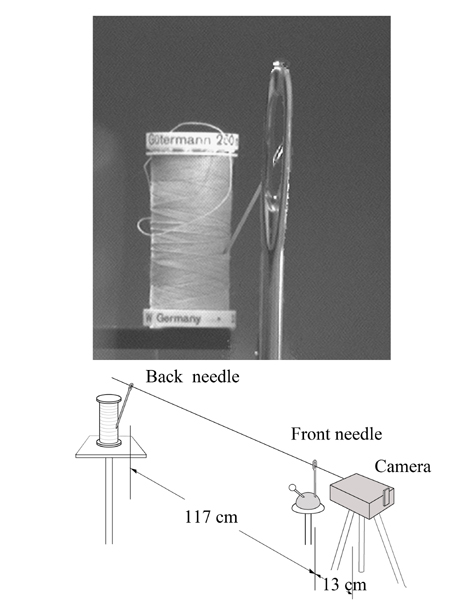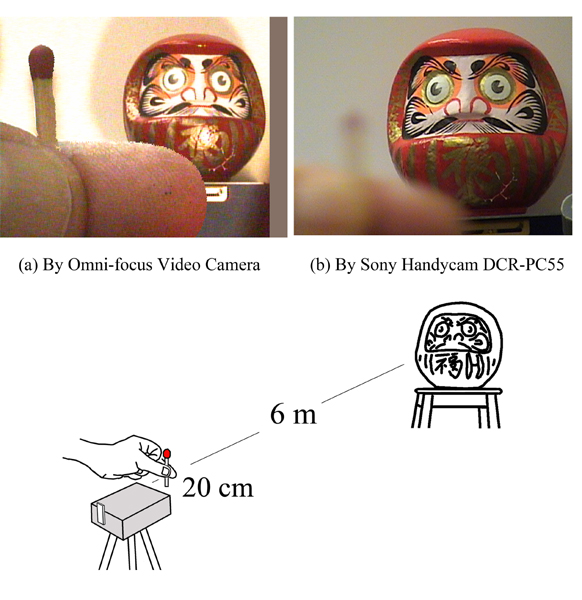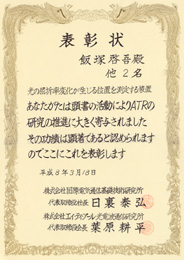
The eye of one sewing needle is taken through the eye of another.

Comparison of Omni-focus Video Camera image (left) and ordinary video
camera image (right).
|
|
This video camera is the first of its kind. The Omni-focus
Video Camera is able to focus any object, near or far, with high image quality
and without the cameraman physically having to move the camera optics in
order to focus. The power of resolution of the image is limited only by
the size of a pixel of the video camera. Even fingerprints in the image
are recognizable.
|
|
Iizuka discovered that a 25-micron-thick sheet
of cellophane is better at rotating the polarization direction of white
light (400 to 700 nm) than a half-waveplate designed for a specific wavelength.
The cellophane half-waveplate was used to convert an ordinary laptop screen,
a camera phone, a laparoscope, a camcorder, and most recently a microscope
into a three-dimensional display. Click illustrated
explanation to learn more about this exciting new development. Iizuka's
results were published recently in Review of Scientific Instruments
and Applied Optics:
|
| A unique feature of this 3D laparoscope is
that it includes a virtual ruler to measure axial distances without physically
touching affected area. The cover page picture to the left shows (a) Light
traces showing the superimposed image of the light ruler. (b)Without the
light ruler, (c) With the light ruler touching the gallbladder, and (d)
With the light ruler penetrating into the gallbladder.
The structure is sturdy and displays true color in real time and its diameter is no bigger than a standard 10 mm diameter laparoscope.:
|
|
There are many kinds of clear wrapping paper on the market. Some look just like cellophane, but they are not birefringent (no fast and slow axes). This article includes an explanation of a simple polariscope improvised by two polarizer sheets for verifying the birefringence necessary for the 3D display application.
|
|
Physics News Update is a digest of physics news items arising from physics meetings, physics journals, newspapers and magazines, and other news sources. Iizuka's article in Review of Scientific Instruments, August 2003, was featured in Physics News Update:
|
|
Optics.org is an online photonics resource designed to serve the information needs of the worldwide photonics community. Click the link below to read Jacqueline Hewett's news article on Iizuka's discovery:
|
The decay rate of the illuminating light with
distance due to the divergence of the light is used as a means of mapping
the distance. Click here for the principle
of operation. Special features of this camera are its high resolution, real
time operation, simplicity, compactness, light weight, portability, and
yet low fabrication cost.
|
|
The Axi-Vision Camera is a 3D television camera that can capture depth images simultaneously with the color image. Since the invention, this technique has been employed as a standard image-synthesizing technique that combines camera-based images with computer-generated graphics, and a new technical word "depth-keying synthesis" was born. Programs produced by this synthesis have been broadcast from NHK, Japan.
|
|
|
In a contest sponsored annually by Optics and Photonics News of the Optical Society of America, the paper on the Axi-Vision Camera was selected as one of the most significant scientific accomplishments described in a refereed journal in 2002. |
 [Fujio Frontier Award] |
The Institute of Image Information and Television Engineers of Japan presented the NHK team members and the Iizuka team members the 2003 Fujio Frontier Award in recognition of their leading edge research and development of the Axi-Vision Camera. |
|
To view scenes recorded with the aid of the Axi-Vision Camera, click the following links: |
 ATR Award |
The combination of the invention of the ultra high precision
phase discriminator with a superstructure grating laser source made possible
an optical version of the microwave synthetic aperture radar. Three-dimensional
laser microvision, being radar in nature, alleviates the common shortcoming
of the uncomfortably shallow depth of focus of a high power microscope.
Advanced Telecommunication Research presented Iizuka's team the ATR Excellence
in Research Award for this project in 1996.
|